syndicated
Latest
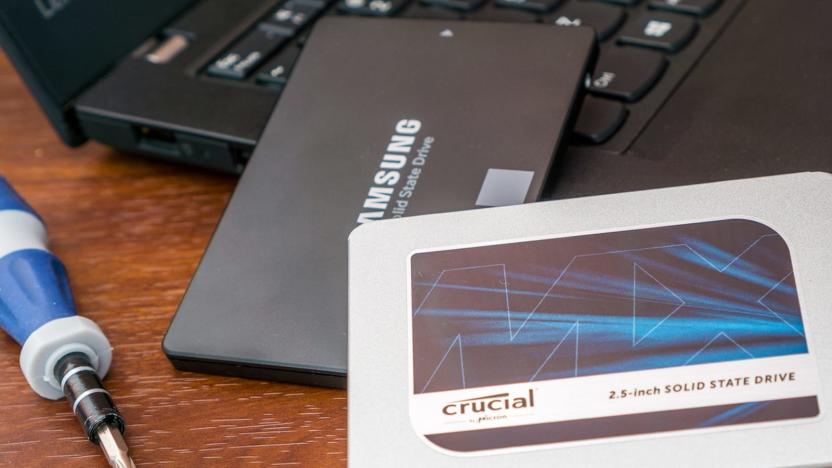
The best SSDs
By Andrew Cunningham This post was done in partnership with Wirecutter. When readers choose to buy Wirecutter's independently chosen editorial picks, Wirecutter and Engadget may earn affiliate commission. Read the full guide to SSDs. Whether you're replacing an existing solid-state drive or upgrading from a traditional hard drive to get better performance, almost every SSD you can buy today is great. But some are still better than others. If you need to buy a SATA SSD right now, we think the 500 GB Crucial MX500 is the best option for most people. The MX500 isn't the fastest SATA SSD you can get, but it comes close, and it has the best combination of price, performance, endurance, and capacity of any drive you can buy. The Crucial MX500 is just a little slower than Samsung's more expensive SATA SSDs in most benchmarks, but most people wouldn't notice the difference. It's as good as or better than the rest of the competition and it performs better when full or near-full than its predecessor, the MX300. It supports full-disk encryption and it comes in both 2.5-inch and M.2 SATA versions, but not the (older, less common) mSATA. Crucial offers a five-year warranty on the drive for more peace of mind (three years is typical), The Samsung 860 Evo replaces the 850 Evo, which was our top SSD pick for nearly three years. Compared with both its predecessor and the Crucial MX500, the 860 Evo is a little faster and offers much better durability. And in addition to the 2.5-inch and M.2 versions, it's available as an mSATA drive, unlike the MX500 and most other modern SSDs. But it's usually more expensive than the MX500, and you won't notice the difference between the two in day-to-day use. The MX500 is the drive to get as long as it's cheaper. Any good SATA SSD will help your PC boot quickly, speed up app launches and load times for games, and generally make your computer more responsive; most people, including gamers, don't need anything faster. But serious video and photo editors, server admins, CAD designers, software developers, and other people with workstation-style demands—anyone who frequently loads and saves large files—may benefit from a faster drive. If that describes you, choose the PCIe Samsung 970 Evo Plus, which can be four or five times faster than the fastest SATA drives. It's more expensive—typically $50 or $60 more than a good SATA drive for 500 GB and around $120 more for 1 TB—and you'll need a desktop or an M.2 PCIe–equipped laptop to use it. Just remember that the difference between a SATA SSD and a PCIe SSD isn't as noticeable as the difference between a SATA SSD and a spinning hard drive. Western Digital's WD Blue SN500 is a budget M.2 PCI Express SSD that's faster than (and around the same price as) the SATA-based MX500 or 860 Evo. It's the best option if you're building a new desktop computer, configuring a barebones mini PC, or upgrading a one- or two-year-old laptop that you bought with a smaller SSD and you want a fast drive for a lot less money than the 970 Evo. But most people will be just fine with a SATA drive (and you also shouldn't upgrade to the SN500 from a SATA SSD of an equal or greater capacity). The SN500 performs well for the price and comes with a solid five-year warranty from a reliable company. But it comes in only 250 and 500 GB capacities, it doesn't support hardware encryption acceleration, and like all M.2 PCIe drives it will work in only newer PCs.

The best wireless charging station now that Apple AirPower is dead
By Nick Guy This post was done in partnership with Wirecutter. When readers choose to buy Wirecutter's independently chosen editorial picks, Wirecutter and Engadget may earn affiliate commission. Read the full guide to wireless charging stations now that Apple AirPower is dead. Apple's never-released AirPower charging station was an embarrassment for the company; it was the rare product that Apple announced, then cancelled before it could be released. But with so much interest in an all-in-one wireless charging station for an iPhone, an Apple Watch, and AirPods, accessory companies have stepped in to fill the void. Having tried them all, we think Mophie's 3-in-1 Wireless Charging Pad is the best. If you have an iPhone, an Apple Watch, and AirPods with a wireless charging case, you may want to charge all three on a daily basis, and the Mophie 3-in-1 Wireless Charging Pad is the best option to do so wirelessly. An indentation in the shape of the AirPods case means you don't have to fuss with lining up the AirPods, and the grippy edge prevents your phone from moving around, even if it vibrates with notifications. Plus your watch will charge in landscape orientation so that you can utilize Nightstand mode and keep the time displayed. It charges everything just as quickly as the competition, but the design is both more attractive and more thoughtful. No other charging station offers any combination of better features, and they all cost about the same. If you (gasp) don't have AirPods or would rather have the ability to charge a second phone—your partner's or a work phone, for example—we recommend the Zens Dual+Watch Aluminum Wireless Charger. While you can still charge AirPods, this flat design allows you the freedom to swap in whatever Qi-compatible device you choose. But if you do have AirPods, it's less convenient since it can be hard to align the case just right, and the elevated Apple Watch charging puck isn't as handy if you use the watch as an alarm clock.

The best smart outdoor lighting for backyards, pathways and more
By Rachel Cericola This post was done in partnership with Wirecutter. When readers choose to buy Wirecutter's independently chosen editorial picks, Wirecutter and Engadget may earn affiliate commission. Read the full guide to smart outdoor lighting for backyards, pathways, and more. Outdoor lighting isn't a splurge—it can save you from tripping on a dark pathway (again) or having to fumble for the right key. It enhances home security, and it can even light up a party. Smart outdoor lighting takes it to another level by adding automation, remote control, and other convenience features. We spent a month testing outdoor-rated smart bulbs, sconces, path lights, and spotlights, and found the best options for every outdoor scenario. The only smart outdoor bulb we tested with a built-in motion sensor, the floodlight-style Sengled Smart PAR38 LED Bulb can light up a driveway or backyard when you need it and not when you don't. It requires a Zigbee hub, but it also works directly with an Amazon Echo Plus. The motion sensor is especially useful if you want an outdoor bulb for security purposes, and you can adjust its settings so that it doesn't trigger too frequently or at the wrong time. The Ring Pathlight offers a near-instant option for providing helpful and elegant lighting to areas that may be tricky to navigate in the dark such as walkways or patios. It's powered by four D batteries, so you have no wires to deal with, and you can directly control it using an app or set it to turn on and off automatically through a built-in motion sensor. Because this model relies on non-rechargeable batteries, it's meant to light up for short periods of time—less than 15 minutes—so it may not be the best choice for anyone who needs constant lighting. The Philips Hue White and Color Ambiance Calla Bollard is the best-looking smart outdoor light we tested—it's a perfect addition to any party. It has a slick design with a color-changing, dimmable LED at the top that can match outdoor decor or your mood. It does require a hub, such as the Hue Bridge, the Amazon Echo Plus, or the SmartThings Hub. It also requires a power supply (included in the base kit), which can accommodate up to five fixtures.

Wirecutter's best deals: The Eero Pro mesh networking kit, and more!
This post was done in partnership with Wirecutter. When readers choose to buy Wirecutter's independently chosen editorial picks, it may earn affiliate commissions that support its work. Read Wirecutter's continuously updated list of deals here.
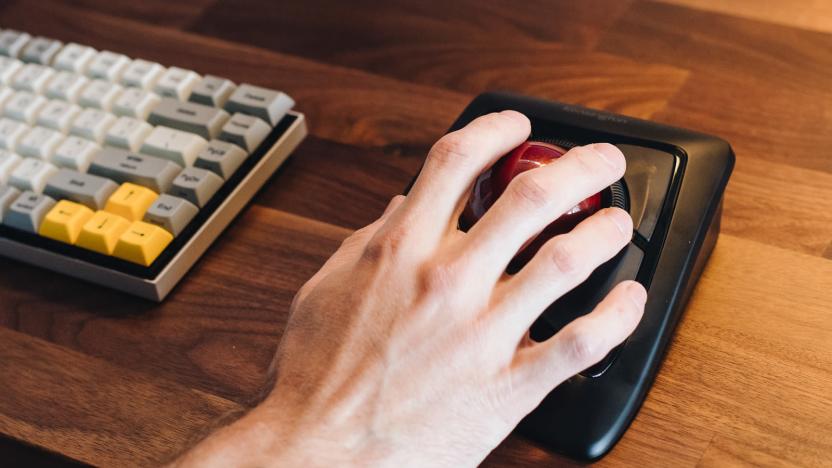
The best trackballs
By Thorin Klosowski This post was done in partnership with Wirecutter. When readers choose to buy Wirecutter's independently chosen editorial picks, Wirecutter and Engadget may earn affiliate commission. Read the full guide to trackballs. After spending more than 120 hours testing eight trackballs during weeks of work, we found that the best trackballs are the finger-operated Kensington Expert Mouse Wireless Trackball and the thumb-operated Logitech MX Ergo Wireless Trackball. We also have budget picks—the Kensington Orbit Trackball with Scroll Ring and the Logitech M570 Wireless Trackball—if you don't mind sacrificing build quality and a couple of features for a more affordable trackball. Finger-operated trackballs with center-mounted balls work for both right- and left-handed people and encourage better wrist posture, while thumb-operated trackballs are more similar to traditional mice and therefore easier to get the hang of using. (For more information, see Should you switch to a trackball? below.)

The best iPhone screen protectors
By Nick Guy This post was done in partnership with Wirecutter. When readers choose to buy Wirecutter's independently chosen editorial picks, Wirecutter and Engadget may earn affiliate commission. Read the full guide to iphone screen protectors. You don't have to spend as much as a few trips to the movies on a good glass screen protector for your iPhone—after testing six models, we found the affordable Maxboost Premium Tempered Glass Screen Protector to be the best for the iPhone XS/11 Pro, XS Max/11 Pro Max, and XR/11. It covers the entire active area of the iPhone's display, it's crystal clear, it's as scratch-resistant as anything else we tested, and fingerprints wipe right off. It includes a nice selection of cleaning tools, and we found installation to be easy enough. And if you get a speck of dust under the glass on your first attempt, it's not the end of the world—you get three Maxboost protectors in each package. A glass screen protector can't guarantee that you won't break your iPhone's screen. But it can prevent the screen from getting scratched, and scratches can affect glass' structural integrity and make cracks more likely. Glass is more protective than film, and it comes closer to the look and feel of the iPhone's own display. TechMatte's amFilm Tempered Glass Screen Protector for iPhone X/XS/11 Pro, XS Max/11 Pro Max, and the XR/11 uses similar glass as our top pick for the iPhone 8 and 8 Plus, but the included alignment tool has a little more wiggle room than the Maxboost protector for the iPhone X and later, making a perfect installation more difficult. It comes with three pieces of glass, though, meaning that if our pick goes out of stock or jumps in price, you can still get a great protector—and a few shots at a perfect installation—for a good price.

The best wireless mouse
By Justin Krajeski This post was done in partnership with Wirecutter. When readers choose to buy Wirecutter's independently chosen editorial picks, Wirecutter and Engadget may earn affiliate commission. Read the full guide to wireless mice. After researching 42 wireless mice and testing 14, we found that the Logitech M720 Triathlon Multi-Device Wireless Mouse is the best wireless mouse for most people because it is more comfortable to use than nearly every other mouse we tested, connects easily via a USB dongle or Bluetooth, and tracks well on most surfaces. Because of its tall, arched back, the Logitech Triathlon fit into our testers' hands nicely. It was more comfortable than similarly priced options. We never experienced any issues connecting it to both Mac and Windows laptops via USB dongle or Bluetooth, and it can pair with—and quickly switch between—three Bluetooth-compatible devices. Logitech claims that the Triathlon's battery can last for two years; we've been using the same mouse for about 15 months, and it has yet to die. It also has six programmable buttons you can customize using Logitech's Options software and a scroll wheel that toggles between ratcheted and freewheel scrolling. If the Logitech M720 Triathlon is unavailable, we recommend the Logitech M585 Multi-Device Wireless Mouse or the Logitech M590 Silent Wireless Mouse. Both mice have tall 1.6-inch-high backs, and our testers generally found they fit their hands as comfortably as the Triathlon even though they're a little smaller. They can connect through a USB dongle or pair with up to two devices via Bluetooth, unlike the Triathlon's three. Logitech claims that the battery will last for two years. The M585 and M590 have one fewer button than our top pick, and you can customize any of their five buttons with Options. While our panel preferred the Logitech M590's silent buttons, which still provide feedback without a loud, physical click, the mouse is not as widely available or as affordable as the M585. If you spend all day using a mouse, we recommend the Logitech MX Master 2S Wireless Mouse for its comfortable design, its buttons, and its secondary thumb scroll wheel. Since it's nearly a half-inch wider and longer than the Triathlon, our panel found it comfortable for all grips and hand sizes, especially those with bigger hands. It's more than twice as expensive, but it did track even more precisely than the Triathlon in our testing. Like the Triathlon, it can connect to and switch between up to three devices via Bluetooth or dongle. The MX Master 2S has a rechargeable battery that can last for about two months on a single charge. It has six programmable buttons—as many as the Triathlon—that can be customized with Logitech Options software, and it offers a second scroll wheel for your thumb. The Logitech MX Master 3S Wireless Mouse has improved button placement below the thumb scroll wheel, and it's a tad more comfortable to use, but at the time of this writing it's too expensive to recommend over the 2S. If the price drops below $85, it's the best mouse for people who spend all day using one. Our portable pick is the Logitech Anywhere 2S Wireless Mouse. The Anywhere 2S is smaller than most mice we tested—and its back arch was about a half-inch shorter than the Triathlon's—but we found that it was still really comfortable to use over long periods of time. Like all of our picks, it can connect via USB dongle or Bluetooth; it can wirelessly connect with up to three devices. Like the MX Master 2S, the Anywhere 2S has a rechargeable battery that can last for around two months before you'll need to recharge it. It has five programmable buttons (one is hiding behind its scroll wheel), and it offers Options software for you to customize each button to your liking.

The best personal blender
By Lesley Stockton This post was done in partnership with Wirecutter. When readers choose to buy Wirecutter's independently chosen editorial picks, Wirecutter and Engadget may earn affiliate commission. Read the full guide to personal blenders. After spending 28 hours researching two dozen personal blenders and testing 12 models in our test kitchen, we think the NutriBullet Pro 900 Series offers the best balance of power, simplicity, convenience, and price for most people. We pureed almost 25 pounds of frozen fruit, hearty kale, fibrous ginger, gooey peanut butter, and sticky dates into thick smoothies to come to this conclusion. The NutriBullet won us over with its blending abilities, ease of use, and price. The powerful motor didn't strain blending thick mixtures, and it pureed tough kale and frozen fruit into a satisfying drinkable consistency. The blending quality is on par with midrange full-sized blenders without the bulk of a large machine. If you regularly buy a smoothie on your way to the office or class, the NutriBullet Pro will pay for itself within a month. We like the Tribest PB-150 because it's durable and offers the smallest footprint of all our picks. Although the Tribest isn't the most powerful machine on paper—it has a weaker motor and the smallest cups of all our picks—it blends really well for most food prep tasks you'd need it for. Compared to the NutriBullet and Breville Boss To Go, smoothies from the Tribest are thinner due to the extra liquid needed to get a consistent blend. But it's built to last and a solid performer if you don't mind slightly thinner smoothies. The Breville Boss To Go offers smoother blending, sleeker design, and a better travel lid than our top pick. The Boss To Go blended kale the finest, and berry seeds were the smallest of all our picks. The Breville blends thick mixtures easily without straining. The stainless steel housing and sleeker design will look good on your countertop, and the travel lid has the largest opening of all the blenders we tested for easier drinking.
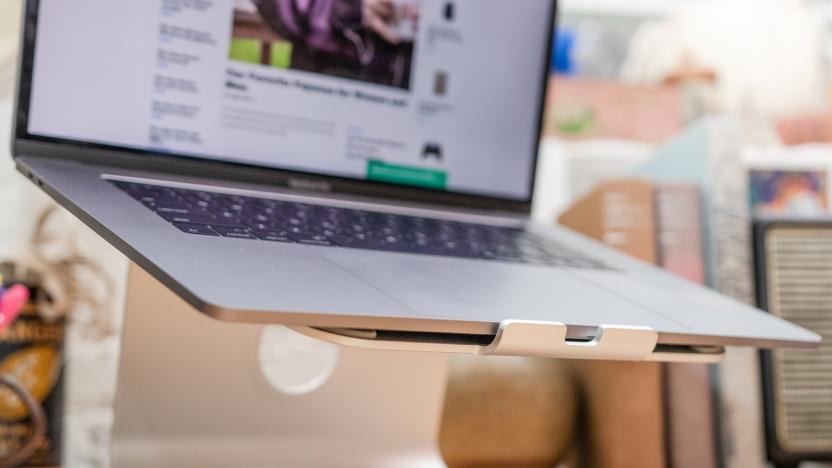
The best laptop stands
By Justin Krajeski and Kimber Streams This post was done in partnership with Wirecutter. When readers choose to buy Wirecutter's independently chosen editorial picks, Wirecutter and Engadget may earn affiliate commission. Read the full guide to laptop stands. After years testing 17 laptop stands at work and in our home offices, we found that the Rain Design iLevel 2 is the best stand for anyone who spends hours every day hunched over a laptop at their desk. None of the other laptop stands we tested matched the iLevel 2's combination of stability, adaptability, and sleek style. Paired with a wireless mouse and an external keyboard, the iLevel 2 can help fix your posture and reduce neck and arm pain. The Rain Design iLevel 2's exceptional build quality and easy adjustability are worth paying for if you need a laptop stand. It held 11-inch to 15-inch laptops with a sturdy grip in our tests, and it has a simple, straightforward design that looks stylish. It's easier to adjust than every other adjustable laptop stand we tested, too: its platform tilts upward when you slide a knob from the left to right. If you want a more affordable laptop stand that looks nicer than a stack of books, the best option is the Rain Design mStand. Like the iLevel 2, the sturdy, aluminum mStand held laptops up to 15 inches in our tests, plus it has a hole for cable management and a nook to store your keyboard. But unlike our other picks, it isn't adjustable. If you need a laptop stand to take between work and home or to use while traveling, the Roost Laptop Stand is the sturdiest and most compact portable option we tested. The Roost is pretty easy to set up and collapse, and it doesn't sacrifice stability; when you're done using the lightweight model for the day, you can fold it into a long, thick stick. Switching between the Roost's three height settings is a bit tricky, but doing so gets easier with practice. The Nexstand Laptop Stand is a decent and affordable portable option if you're willing to give up some portability and ease of use. It's similar to the Roost in design and height, and it's comparably simple to set up and break down. It was stable enough for laptops up to 15 inches in our tests, but it can be less secure than the Roost if you're not careful; for example, its six height settings aren't clearly demarcated from one another, so you need to double-check that your laptop stand is fully locked before placing a laptop on top of it. The Nexstand is a bit bigger and heavier than the Roost, too.
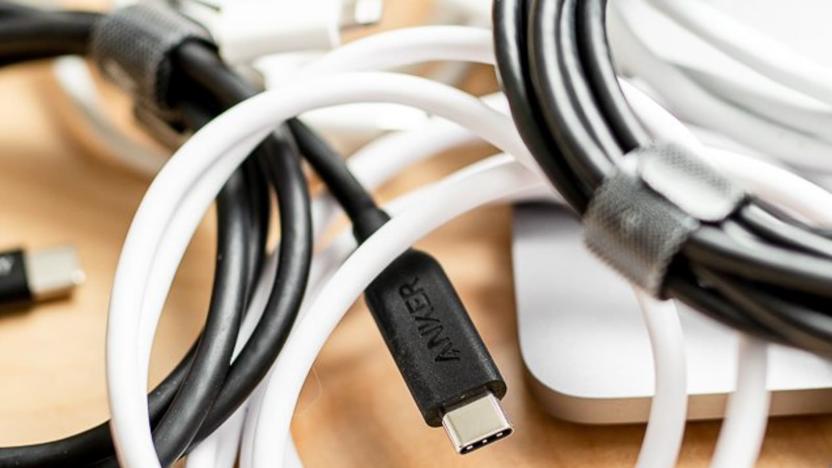
The best USB-C cables and adapters
By Sarah Witman This post was done in partnership with Wirecutter. When readers choose to buy Wirecutter's independently chosen editorial picks, Wirecutter and Engadget may earn affiliate commission. Read the full guide to USB-C cables and adapters. If you have a device with a USB-C port—like a MacBook or Android phone, or 2018 iPad Pro—you're going to need some cables. Unfortunately, when it comes to USB-C, even cables that look identical can perform very differently. Your MacBook's charging cable, for example, has the exact same connectors at each end as a top-speed Thunderbolt 3 cable, but it's different internally; it transfers data at a snail's pace, and it can't send a video signal. To make sure you get the right cable for your needs, we've tested 36 cables and 16 adapters to find the best ones for charging, data transfer, video, and more.
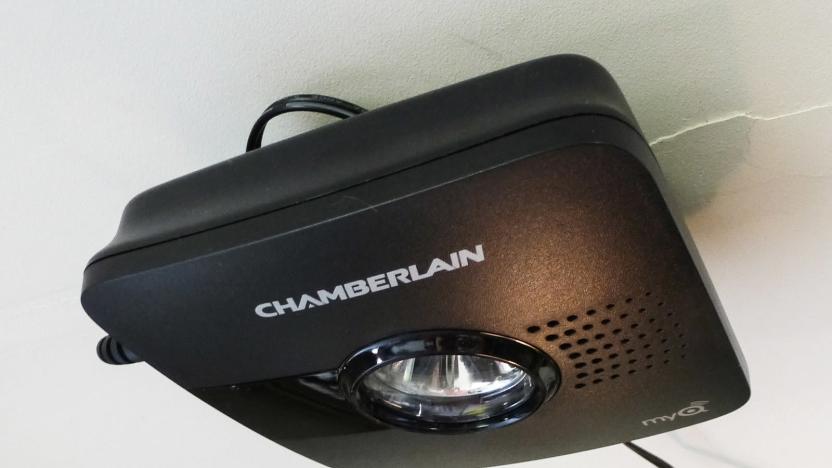
The best smart garage-door controller
By Jennifer Pattison Tuohy This post was done in partnership with Wirecutter. When readers choose to buy Wirecutter's independently chosen editorial picks, Wirecutter and Engadget may earn affiliate commission. Read the full guide to smart garage-door controllers. After spending over 20 hours wiring and rewiring garage-door openers, opening and closing the doors with our smartphones and our voices, and controlling them through smartphone apps and home-automation routines, we found that the Chamberlain MyQ Garage (MYQ-G0301) is the best smart garage-door controller for most people. It was the easiest and quickest to install of all the controllers we tested, it's among the simplest to set up and use, and it's compatible with the most garage doors out there, thanks to the huge popularity of Chamberlain and LiftMaster products in homes across the country. It also integrates with the popular Nest Cam if you want a remote view of your garage. With the addition of an optional bridge, MyQ can work with Apple's HomeKit smart-home platform, too. Chamberlain's MyQ Garage is a great choice for extending the remote-control operation of your garage door beyond your home. The MyQ Garage integrates with Nest, Wink, and Xfinity Home smart-home hubs. Apple HomeKit compatibility is available with the purchase of the MyQ Home Bridge, and Google Home and IFTTT are offered for a $10 annual subscription. MyQ can also integrate with the Google Assistant on smart devices, like the Google Home, but you'll have to pay for an integration service ($1 per month or $10 for a year). The MyQ Garage also works with the MyQ smart light switch and smart lamp controller, letting you turn on the lights and air conditioning as you open the garage door, if you like. It is also compatible with Amazon's Key in-garage service for Amazon Prime customers in certain cities. Of the controllers we tested, the Gogogate2 boasts the most useful features and is the smallest, most lightweight, and least obtrusive (the MyQ Garage comes in a close second in size). Its app opened and closed the door seamlessly and simply every time. It's compatible with a wide range of garage doors, and it integrates directly with many IP security cameras if you want to see your garage door in real time. You can also check the temperature inside your garage, share access with up to 10 users for free, and automatically open and close your door using geolocation and voice, through integration with IFTTT and Amazon's Echo. The downsides are a more complicated install than for the other units we tested, little support for integration with smart hubs despite its smarts, and the lack of an ability to set custom alerts when the garage door is left open. If you already have a smart-home automation system installed, and you find the Gogogate2's lack of hub compatibility to be a dealbreaker, the GoControl/Linear Z-Wave Garage Door Opener Remote Controller is the most "vanilla" model out there, with Z-Wave control allowing you to add as many sprinkles and toppings as you are comfortable with through your choice of hub. The GoControl is the least expensive option for off-site remote control of your garage door.
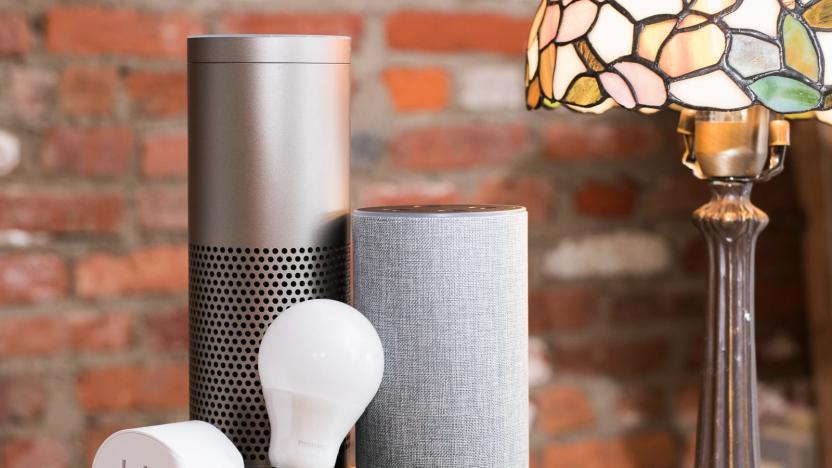
The best Alexa-compatible smart-home devices for Amazon Echo
By Rachel Cericola This post was done in partnership with Wirecutter. When readers choose to buy Wirecutter's independently chosen editorial picks, Wirecutter and Engadget may earn affiliate commission. Read the full guide to Alexa-compatible smart-home devices for Amazon Echo. Imagine walking into your home at night, arms overflowing with groceries. Even if you've installed smart lights, you'd need to put the bags down, pull out your phone, unlock it, open the app, find the control for the lights you want, and then tap the icon—might as well just stick with a plain old wired switch. But with an Alexa, you simply say, "Alexa, turn on the kitchen lights." And it's not just lights; Alexa is capable of controlling everything from basic smart plugs to garage doors. All three smart-speaker platforms (Alexa, Google Assistant, and to a lesser degree, Siri) can control a variety of smart-home devices and add an extra level of convenience to your smart-home system. We think Amazon's Alexa has a slight edge over the others because it works with more devices, and the wider family of Amazon Echo products makes it easier to fit them everyplace in your home. However, if you already have a Google Home speaker, the differences aren't large enough for you to need to switch platforms. We have guides for the best devices to use with Google Assistant and Siri/HomeKit. The Amazon Echo (or Echo Dot) offers a convenient interface for your smart home and provides functionality that an app on your phone can't. If you already have some Alexa-compatible devices or one of the three major smart-home hubs (SmartThings, Wink, or Insteon), adding an Echo can make accessing those devices more interesting and convenient. Taking advantage of its near-instantaneous response time and reliable voice-recognition processing is significantly faster than pulling out your phone and opening an app just to turn the lights on or off. Some products, such as Philips Hue lights and Nest thermostats, have native Alexa support, while others require you to enable a third-party skill. We tested plenty of both varieties to come up with the best-performing and most reliable recommendations, which we're continually testing to ensure that each new firmware and app update meets our high standards. Over the past several years, Wirecutter's editors and writers have tested just about every smart-home device of consequence. As more people end up buying smart speakers and platform support gets more and more important, we wanted to provide one place where you could access all of our picks that are compatible with the devices you already own, across all of our smart-home recommendations. Because these devices receive regular updates with additional compatibility and new features, we are continually testing and reevaluating our picks in our own homes to confirm that they still meet our recommendation standards. We'll update this guide as we learn new information, but be sure to read the full reviews if you'd like more details and test notes. If you don't yet have an Alexa-enabled device, or you want to learn more about what Alexa is and what you can do with these things, check out our full guide to Alexa and Amazon's Echo line of smart speakers.
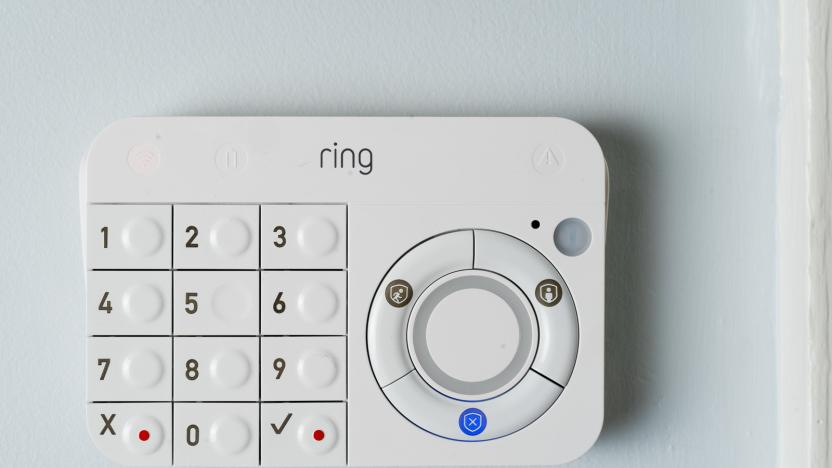
The best home security system
By Rachel Cericola This post was done in partnership with Wirecutter. When readers choose to buy Wirecutter's independently chosen editorial picks, Wirecutter and Engadget may earn affiliate commission. Read the full guide to home security systems. Peace of mind doesn't have to be pricey. Home security systems often require long contracts and pro installation, but there are smart systems you can install yourself that include a monitoring plan to keep tabs on it—and only when you want that. We found Ring Alarm to be the most affordable, comprehensive, and easy-to-use DIY home security system that has both self-monitoring and professional-monitoring options and doesn't lock you into a contract. Ring Alarm is the most comprehensive system we tested, with the most affordable monitoring plan we found. You can expand it with a variety of Ring security cameras, including indoor, outdoor, and video doorbell cameras. It also integrates with several third-party devices via the Works With Ring program, which includes brands such as First Alert, GE, Kwikset, Leviton, Schlage, Yale, and others, giving you more customization choices than other systems offer. It's also one of the few systems to provide both arming and disarming via Alexa voice commands with a four-digit PIN. Plus, you get 24/7 live customer service. SimpliSafe has a better-looking system than Ring, with voice prompts and support for Google Assistant as well as Amazon Alexa (but not Apple HomeKit). It also has add-ons such as a video camera, a doorbell camera, smoke alarms, and additional sensors. Unlike the Ring Alarm system, however, it doesn't offer outdoor cameras or self-monitoring options; you also can't add any non-SimpliSafe devices, and live customer service is available only from 9:00 a.m. to 12:00 a.m. Eastern.
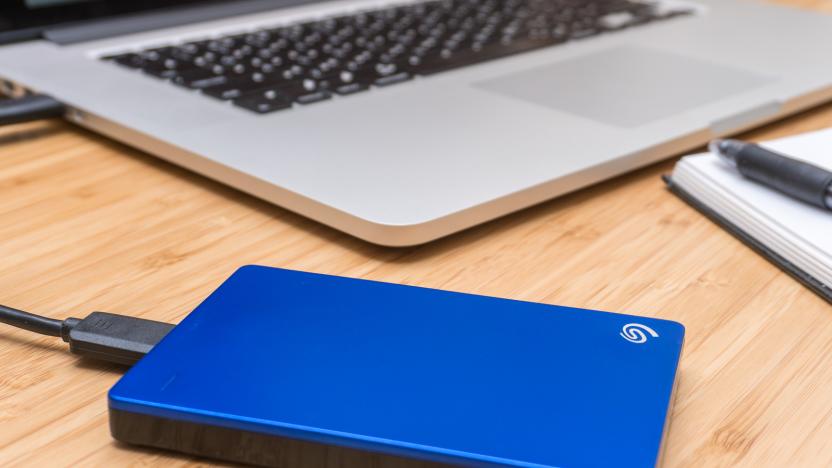
The best portable hard drive
By Justin Krajeski This post was done in partnership with Wirecutter. When readers choose to buy Wirecutter's independently chosen editorial picks, Wirecutter and Engadget may earn affiliate commission. Read the full guide to portable hard drives. After 18 hours of new research and testing, we found that the 2 TB Seagate Backup Plus Slim is still the best portable hard drive for most people. It's reliable, it's one of the lightest, thinnest hard drives we tested, and it was faster than the competition in our backup and file-transfer tests. The Slim has been one of our top picks for the past four years, and it's the only portable hard drive that we've tested that doesn't sacrifice size, speed, or reliability. Every other 2 TB portable hard drive is significantly larger, performs slower in our tests, or has a failure rate that's too high to recommend. The Slim has an acceptable 9-percent reported failure rate among nearly 2,701 user reviews. We recommend the 2 TB model because it's a great value. Seagate includes handy backup software, too. If you want more storage and don't mind a larger, heavier drive, we continue to recommend the 4 TB Seagate Backup Plus Portable, which costs less per terabyte than the 2 TB Backup Plus Slim. It was faster at sequential reading in our HD Tune test, but it was slower in our other testing. It's twice as thick as our top pick and almost twice as heavy, too. (Make sure not to buy the 4 TB Seagate Backup Plus Fast by mistake—that's a different drive that we do not recommend.)

The best robotics kits for beginners
By Signe Brewster This post was done in partnership with Wirecutter. When readers choose to buy Wirecutter's independently chosen editorial picks, Wirecutter and Engadget may earn affiliate commission. Read the full guide to robotics kits for beginners. When we tested robotics kits for beginners, the Lego Boost set won over the toughest critics: kids. And robotics pros, makers, and hobbyists agreed. With its Lego-based design, built-in sensors, and expansive options for creativity, the Boost kit was the most fun to build with. Plus, the tablet app's super-simple programming was the easiest to learn of any of the kits we tried. Since it uses Lego pieces, the Lego Boost set is the most approachable and the easiest to figure out how to put together. It's a well-thought-out kit that a panel of child testers enjoyed as much as we did. The simple programming interface is easy to get started with, and the visual instructions allow non-readers to use and enjoy it, though more advanced programmers might find it limiting. If our main pick is unavailable, the next-best option is the Ubtech Jimu Robot AstroBot Series: Cosmos Kit. The companion smartphone and tablet app that leads you through building and programming is the most organized and simple to learn of any we tried. The clear instructions offer a straightforward introduction to the popular Scratch programming language. The blocklike Jimu building pieces aren't as versatile as Legos, and they feel a little clunky, but they come together to build a capable robot. If you're hungry to do as much as you can with a robotics kit, the Vex IQ Super Kit will satiate your appetite for new skills whereas simpler and less expensive kits may only be an appetizer. You can begin programming this kit with a graphical language or move up to more complex tasks using the C programming language, and the extra sensors—which can detect colors, for instance, or when the robot bumps into something—add possibilities that simple kits lack. The kit is made for educators, and as a result it has some of the most solid pieces and packaging.
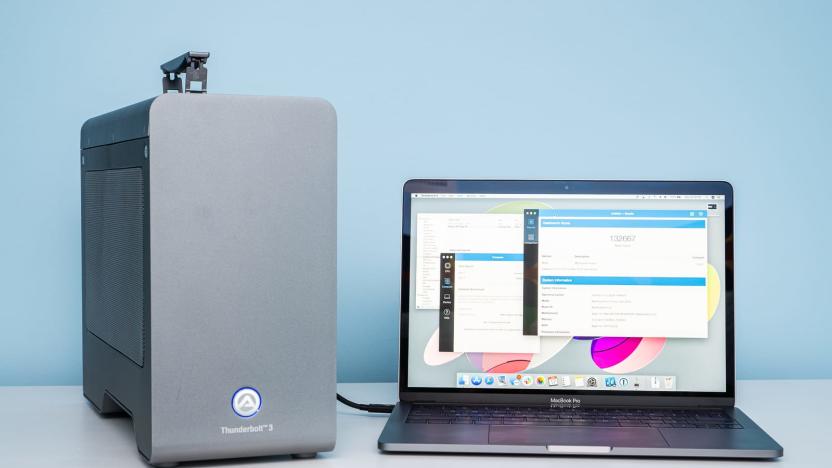
The best external graphics card enclosure
By Andrew Cunningham This post was done in partnership with Wirecutter. When readers choose to buy Wirecutter's independently chosen editorial picks, Wirecutter and Engadget may earn affiliate commission. Read the full guide to external graphics card enclosures. For laptops or mini PCs with Thunderbolt 3 ports, adding an external graphics card (or eGPU) can be a good way to play high-end games, run professional 3D apps, and connect as many as half a dozen monitors. After researching nearly 30 Thunderbolt 3 eGPU enclosures and testing six, we think Akitio's Node Pro is the best box you can buy to put your graphics card in. The Akitio Node Pro is a bit slimmer than other eGPU enclosures and has an understated, all-metal design that looks better than most of the plain black boxes in this category (it looks especially at home next to Macs). You can open it and install or swap out graphics cards without any tools at all—on most enclosures you need at least a screwdriver to access the interior—its fan is relatively quiet, and it has a second Thunderbolt 3 port that you can use to connect other accessories. It can provide up to 60 W of power to a connected laptop, more than enough to keep most 13-inch notebooks charged while you use them. And it has a neat retractable handle you can use to carry it from place to place. The Razer Core X Chroma is bigger, boxier, and more expensive than the Node Pro, but it also includes a Gigabit Ethernet port, four USB 3.1 Gen 1 Type-A ports for connecting accessories, and customizable RGB lights that can add a flashy, colorful touch to your gaming setup. It can also provide up to 100 W of power to a connected laptop, enough for some 15-inch laptops like Apple's 15-inch MacBook Pro (though others exceed USB-C's 100 W charging limit). If you're looking for a Thunderbolt 3 graphics card enclosure that can double as a laptop dock, this is the one to get. The 550 W version of Sonnet's eGFX Breakaway Box (which also comes in a 650 W version) typically costs between $100 and $150 less than our other picks, money that you could put toward a more powerful graphics card. But its design is more utilitarian than that of our other picks, it's not as easy to open, and its fan is a bit noisier. These shortcomings are forgivable for the price, but most people will be better served by the Akitio Node Pro.
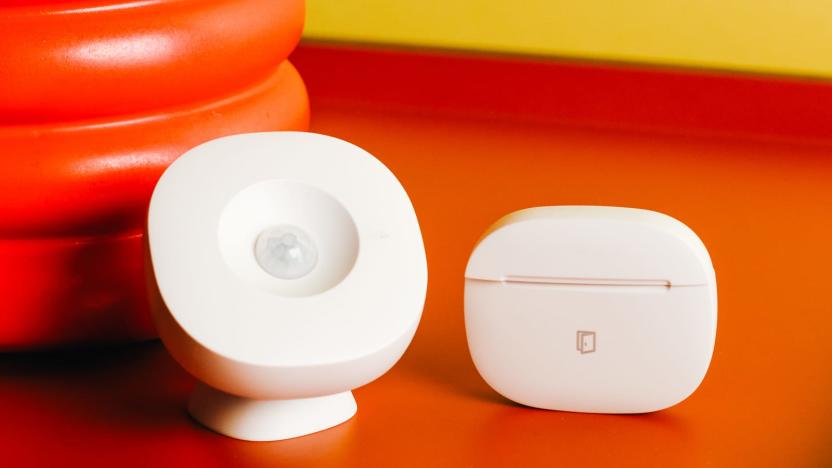
The best smart home sensors for Alexa
By Jennifer Pattison Tuohy This post was done in partnership with Wirecutter. When readers choose to buy Wirecutter's independently chosen editorial picks, Wirecutter and Engadget may earn affiliate commission. Read the full guide to smart home sensors for Alexa. Among Alexa's many tricks is that it also works as a smart-home hub. And adding smart sensors to an Echo Show or Echo Plus can turn either device into more than just an opponent for 20 Questions. Different sensors detect activity such as motion, a door or window opening, and temperature, and then tell other devices how to react. We recommend the Samsung SmartThings Motion Sensor and Samsung SmartThings Multipurpose Sensor for their reliability and wide compatibility with other devices. The Samsung SmartThings Motion Sensor stands out among the few Alexa-compatible sensors because its long range lets it easily cover a large room (or even two), it can trigger in reaction to temperature as well as motion, and it's super easy to pair with an Echo Plus or Echo Show (no SmartThings hub needed), so you can run Alexa Routines based on motion or temperature changes in the room. It's a breeze to install, and thanks to a magnetic mount that's easy to adjust, it fits almost anywhere you need it. The sensor is also water resistant (although it's recommended only for indoor use). At a typical price of just $20, the tiny Samsung SmartThings Multipurpose Sensor (Zigbee) does a lot for very little. Its main purpose is to serve as a contact sensor, and you can easily stick one of these on any door, window, or drawer to detect when they open or close. But it also has temperature and vibration sensors inside, so it can alert you—or act as a trigger for other smart devices—if a room or area is too hot or too cold. That makes it the most versatile sensor we tested: You can just as easily keep tabs on the doors and windows of a rental property as on a precious liquor cabinet.
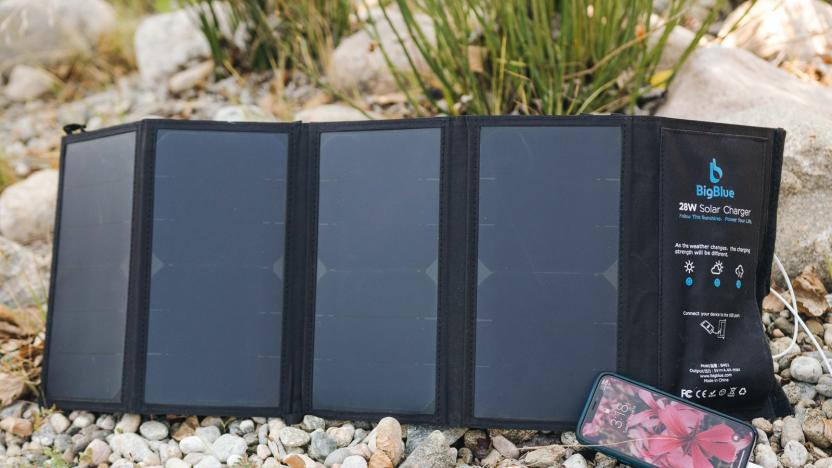
The best portable solar battery charger
By Sarah Witman This post was done in partnership with Wirecutter. When readers choose to buy Wirecutter's independently chosen editorial picks, Wirecutter and Engadget may earn affiliate commission. Read the full guide to portable solar battery chargers. Unlike the finite energy stored in a battery pack, a USB solar charger offers a tiny power plant that can generate power for your phone and small electronics to keep them charged when the sun is out—you can even use one to recharge a power bank and save that energy for later. After spending more than 60 hours testing 12 models, we're confident that the BigBlue 28W USB Solar Charger is the best portable solar charger for people who need to charge their gadgets and stay connected in an emergency or when they're off the grid. The BigBlue 28W USB Solar Charger produces the most power of any portable solar charger we've tested, and it has unique features that make it more versatile and durable, including three output ports (versus two on most other chargers), a weatherproof port protector, and an expansive but lightweight array of panels to catch every last ray of sunlight. Although other models come close to matching it in terms of power, the BigBlue is also smaller and lighter than other options with similar output, so it can more easily fit into a camping backpack, hiking daypack, or emergency kit. If the BigBlue is unavailable, we also like the X-Dragon 20W SunPower Solar Charger. In testing, it was second only to our top pick in terms of how much power it produced throughout the day, and it even produced a little more when the sun was at its peak midday. While this model will charge up your devices just as fast as our top pick, the X-Dragon lacks the convenient extras—such as the additional charging port and the port protector—that make the BigBlue stand out.
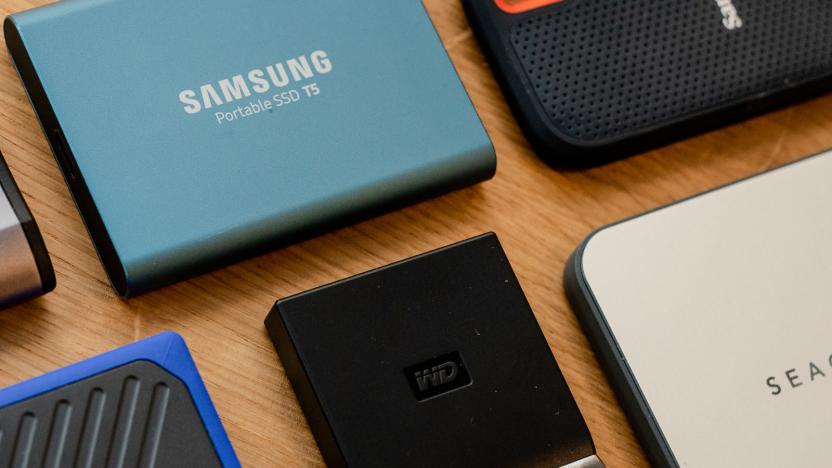
The best portable SSD
By Justin Krajeski This post was done in partnership with Wirecutter. When readers choose to buy Wirecutter's independently chosen editorial picks, Wirecutter and Engadget may earn affiliate commission. Read the full guide to portable SSDs. If you frequently move large files between computers and want a fast, small device to do it with, you should get a portable SSD. After researching 17 portable SSDs and testing the five most promising in 2019, we found that the 500 GB Samsung T5 was the best. It's fast, compact, competitively priced, and reliable, and the one we tested has worked well for the past two years. The 500 GB Samsung T5 Portable SSD is about as expensive per gigabyte as other external SSDs. It's also very light and compact, so you can easily throw it in your bag (or even tuck it inside your pocket) when you're on the go. The T5 has one USB 3.1 Gen 2 Type-C port that supports USB transfer speeds of up to 10 Gbps, and unlike other portable SSDs we tested, it includes cables to connect to both new and old devices, as well as useful AES 256-bit hardware encryption to protect your sensitive data. The T5 had software that was pleasant to navigate, with a clean layout; other portable SSDs we tested didn't include software, or their software was bloated and less intuitive. With the T5, it's a breeze to set up encryption or check for updates. Plus it has an indicator that lights up when it's connected and blinks while it's actively transferring (a minor perk, but one that makes life easier), and it comes with a three-year warranty. If you want more storage and you're willing to pay for it, we recommend the 1 TB Samsung T5 Portable SSD. Since higher-capacity solid-state drives often provide slightly improved performance, we expect the 1 TB version to be a little faster than the 500 GB model, although we weren't able to test it. It's otherwise identical to the 500 GB model in size and features, and it costs about the same per gigabyte as the 500 GB version. If the Samsung T5 is sold out or unavailable, or if the T5 is significantly more expensive, we recommend the 512 GB Western Digital My Passport SSD. Like the T5, the My Passport SSD supports USB 3.1 Gen 2 transfer speeds, and in our testing it was about 10 MB/s slower than the Samsung T5, a borderline imperceptible difference. The My Passport SSD is longer, thinner, and a bit lighter than the Samsung, but they're both pretty darn compact—and they're smaller than everything else we tested that performed comparably. It has one USB-C port and comes with a USB-C–to–USB-C cable, as well as a tiny USB-C–to–USB-A adapter, which seems easy to lose compared with the USB-C–to–USB-A cable that comes with the Samsung T5. Like the Samsung—and unlike its competition—the My Passport SSD has AES 256-bit hardware encryption to reliably protect your sensitive information. And it comes with a solid, three-year warranty. But some Amazon reviewers found its software annoying, and it lacks the Samsung's helpful activity indicator light.
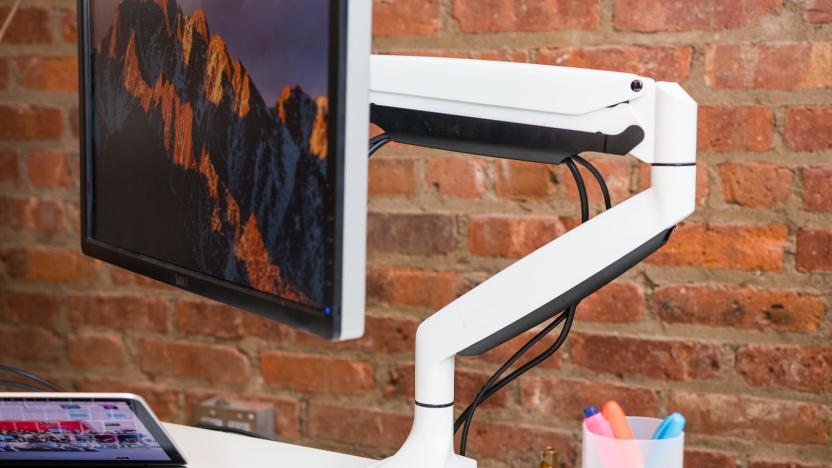
The best monitor arms
By Anna Perling and Jordan McMahon This post was done in partnership with Wirecutter. When readers choose to buy Wirecutter's independently chosen editorial picks, Wirecutter and Engadget may earn affiliate commission. Read the full guide to monitor arms. A great monitor arm can save space on your desk and make your workspace more comfortable and ergonomic. After researching more than 60 monitor arms and testing 13 over the past two years, we found that the Fully Jarvis Monitor Arm is the best option. It's easy to set up, it moves smoothly into a wide range of positions and angles, and it has a solid five-year warranty. The Fully Jarvis Monitor Arm has the same wide range of motion and sturdy build quality as its closest competitors but adds a sleeker design, three color options, and a five-year warranty without a huge price leap. Since it can support monitors up to 32 inches and about 20 pounds, it should work not just with the display you have now but with a potential upgrade in the future as well. If you're considering our runner-up standing desk, Fully gives you a discount on the monitor arm when you buy them together. Supported monitor size: 13 to 32 inches Supported monitor weight: 2.2 to 19.8 pounds Maximum height: 19.8 inches from tabletop If the Fully Jarvis sells out and you can't wait for it to restock, the Ergotron LX Desk Monitor Arm will work just as well. The LX has nearly identical vertical and side-to-side ranges, tilt, and pan and rotation capabilities. Ergotron monitor arms generally cost more than similar options not because of any additional features but because of the company's impressively long, 10-year warranty. Though 10 years may seem like overkill, we think paying for such coverage is a better option than going for the savings provided by other models that offer only a one-year warranty—a monitor arm should last you many years, and the company that makes it should stand behind it. Supported monitor size: up to 34 inches Supported monitor weight: 7 to 25 pounds Maximum height: 25 inches from tabletop People over 6 feet tall need added vertical range to position a monitor at the right height, especially with a desk that lets you switch positions from sitting to standing. The Ergotron LX Desk Monitor Arm, Tall Pole has a 13¼-inch pole and can hold a monitor nearly 15 inches higher than the maximum height of the Fully Jarvis. In our tests we found that the extra height provided an ergonomically ideal range for tall people. In other respects, the Ergotron LX Tall Pole is identical to the standard Ergotron LX arm; it's just as sturdy and easy to assemble. Supported monitor size: up to 34 inches Supported monitor weight: 7 to 25 pounds Maximum height: 34 inches from tabletop If you're looking for a dual-monitor arm, we like the Fully Jarvis Dual Monitor Arm. As with the single-arm versions, the Jarvis dual model costs substantially less than its Ergotron counterpart—in this case, just over half as much—but comes with a shorter warranty. At five years, the Jarvis's warranty is still plenty of coverage, and the simple setup and attractive design make the Jarvis the best dual-monitor arm for most people. Supported monitor size: 13 to 32 inches Supported monitor weight: 2.2 to 19.8 pounds Maximum height: 19.8 inches from tabletop